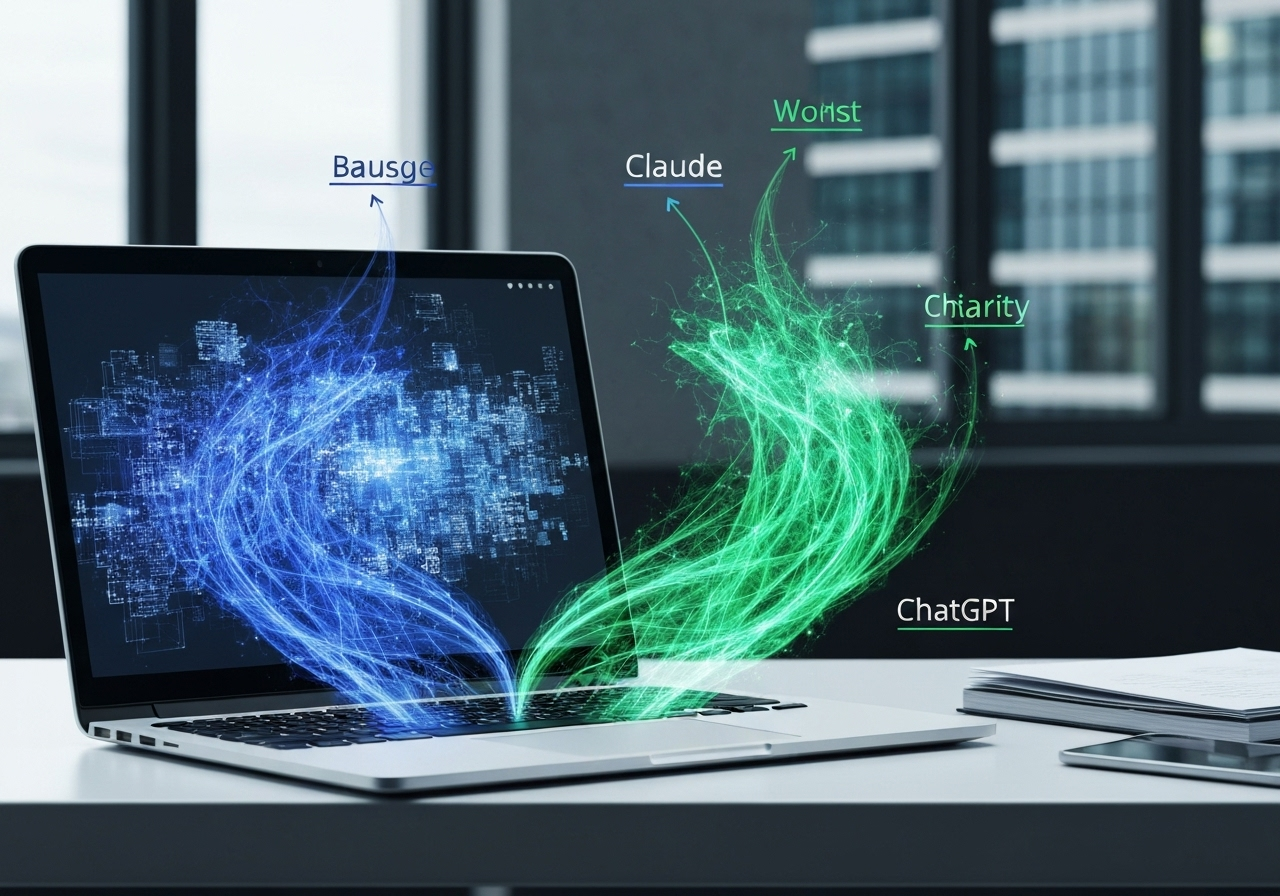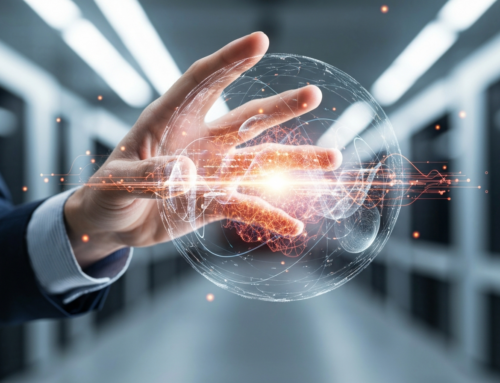Beyond the Benchmarks: Why Professional Users Need a Strategic View of Claude vs. ChatGPT
For small to medium-sized business owners and technical professionals in Charlotte, NC, the choice between Anthropic’s Claude and OpenAI’s ChatGPT is not a matter of simply picking the “smarter” model. It is a strategic decision that impacts everything from data compliance to workflow efficiency. While general benchmarks show both models trading places at the top of the performance charts, the real-world difference lies in their core philosophies and architectural design—specifically, context handling, integration capabilities, and safety guardrails.
To move beyond raw metrics and truly leverage AI for business automation, a discerning user must evaluate which model is the superior fit for their specific operational needs. For instance, Claude’s development, rooted in its “Constitutional AI” framework, prioritizes safety and interpretability, making it the de facto choice for regulated industries. Conversely, ChatGPT’s open, multimodal ecosystem makes it the unrivaled platform for creative velocity and broad application integration. Understanding this fundamental difference is the first step in building robust AI-powered solutions for modern digital growth.
Evaluating Context and Reasoning: LLM Capacity for Complex AI Workflows
The hallmark of a high-value AI workflow is the ability to maintain coherence and accuracy across massive datasets or lengthy, multi-step tasks. In the battle of Claude vs. ChatGPT, this capacity is measured by the token limit of the context window—the amount of information the model can “remember” during a conversation or task execution.
Claude’s models consistently lead the industry in context capacity, often featuring windows of 200,000 tokens or more, which translates to the ability to analyze hundreds of pages of text in a single prompt. This is a game-changer for professional analysis in fields like finance, law, or technical documentation. A financial analyst, for example, can feed Claude an entire annual report, an earnings call transcript, and a complete industry brief all at once, asking the model to cross-reference trends and generate a summary with a single request.
While models like GPT-4o have drastically improved their context management, Claude’s larger context window fundamentally changes the scope of what is possible in a single AI operation. This is especially vital for businesses managing large internal knowledge bases or proprietary documents. When the goal is to conduct deep, holistic analysis on proprietary data, Claude’s superior document comprehension and context retention offer a compelling advantage over systems that require the input to be broken down into smaller, segmented prompts. The utility of this feature extends to all forms of knowledge work, enabling the AI to act as a hyper-focused, deep-dive analyst rather than a quick-answer engine.
Creative vs. Analytical: Comparing Nuance, Tone, and Reliability in Model Output
When selecting an AI co-pilot, businesses must consider whether their primary need is high-velocity creative generation or meticulous, fact-grounded analysis. The output style of each model reflects the core values of its parent company.
ChatGPT: The Creative Accelerator
OpenAI’s models, particularly the GPT-4 family, are generally renowned for their creative versatility and multimodal capabilities. ChatGPT is the clear winner for:
- Marketing Content: Generating a high volume of engaging, diverse-style copy for social media, email campaigns, and product descriptions.
- Multimodal Projects: The seamless integration of DALL-E for image generation (and in the future, Sora for video) makes ChatGPT an all-in-one creative studio.
- Real-Time Information: Its ability to browse the web for up-to-the-minute data and reference current events is indispensable for fast-moving industries.
Claude: The Nuanced Professional
Claude often exhibits a more natural, less “robotic” or verbose tone, making its raw text output often require less editing for a professional voice. It excels in scenarios demanding nuance, consistency, and a high degree of ethical consideration:
- Long-Form Drafting: For technical reports, legal summaries, and internal policy documents, Claude’s output is consistently clear, structured, and avoids the repetitive phrasing sometimes seen in its competitor’s text generation.
- Safety and Compliance: The model’s constitutional alignment means its responses are explicitly framed around helpful, harmless, and honest principles, offering a stronger foundation for regulated or sensitive business communications.
For our clients seeking refined, authoritative thought leadership content, Claude’s strength in thoughtful output and ability to maintain narrative consistency over vast contexts often provides a more reliable starting point than the expansive, but occasionally generic, output of ChatGPT.
Agentic Coding and Real-Time Visualization: Choosing the Best Development Co-Pilot
For development teams in Charlotte, NC, AI models are quickly evolving from simple code generators to full-fledged agentic co-pilots that can write, debug, and refactor complex codebases. The comparison here shifts from general intelligence to practical developer experience and measurable coding performance.
Coding Benchmarks and Practicality
While both AI families are powerful coding assistants, Claude has demonstrated a superior edge in certain complex tasks. Benchmarks like SWE-bench, which test an AI’s ability to solve real-world software engineering problems, often show Claude’s models (like Sonnet and Opus) outperforming most GPT-4 variants in accuracy and code cleanliness. This indicates a deeper, more contextual understanding of software development principles rather than mere pattern matching. In real-world tests, Claude often produces cleaner, more optimized code and is less likely to use outdated function calls, showcasing a stronger “memory” of best practices.
Developer Workflow Integration
Claude’s flagship feature for developers is **Artifacts**. This system creates a live, editable preview window next to the chat interface. When you ask Claude to write a React component or an SVG diagram, the visual output appears instantly in the Artifact window. This provides:
- Real-Time Visualization: Instantly verify that generated code is rendering correctly without leaving the interface.
- Enhanced Debugging: Quickly request iterative changes and see the front-end or logic updates live, drastically accelerating the debugging loop.
While ChatGPT offers powerful coding tools like Code Interpreter (Advanced Data Analysis), which can execute code in a sandbox environment, Claude’s Artifacts feature offers a more seamless, visual, and rapid feedback loop, positioning it as an exceptional co-pilot for front-end and dynamic code generation tasks.
The Data Dilemma: Which Model Excels at Bulk Processing and Database Cleanup?
Data processing and integrity are non-negotiable for e-commerce businesses and enterprises. The ability of an AI to handle, analyze, and process massive data dumps—such as historical sales logs, CRM exports, or product inventory spreadsheets—is paramount for efficient business operations.
Claude’s massive context window makes it the undeniable champion for single-session bulk processing tasks. Businesses dealing with legacy data or requiring significant **database cleanup** and migration can upload complex files (CSV, JSON, XML) and request immediate, deep analysis. Claude can:
- **Process Larger Files:** Ingest and analyze entire data reports or knowledge bases in a single prompt, preventing the need for manual file chunking.
- **Maintain Contextual Integrity:** Apply consistent logic and rules across a massive dataset for tasks like data normalization, outlier identification, and complex pattern extraction.
- **Offer Auditability:** Due to its Constitutional AI focus, Claude is often preferred for data handling in compliance-sensitive environments, as its reasoning can sometimes be more transparently traced.
Conversely, while ChatGPT’s Code Interpreter is highly capable of statistical analysis, visualization, and manipulation of data within its sandbox, its standard context window can become a bottleneck when analyzing truly enormous, unstructured data files. The strategic advantage of Claude lies in its sheer capacity to ingest and reason over high-volume, contextual information without losing the thread—a crucial component for rigorous database integrity projects.
Connecting the Engine: Integrating Models into N8N Workflows and Custom APIs
The true business value of either model is unlocked not in the chatbot interface, but in its seamless integration into core business systems via an orchestration layer like n8n or custom APIs. For high-growth companies utilizing **e-commerce solutions in Charlotte, NC**, the AI acts as a smart node, managing data flow between the e-commerce platform, CRM, and fulfillment system.
While both Claude and ChatGPT offer robust API endpoints, their surrounding ecosystems dictate which model is easier to deploy for specific automation goals:
The ChatGPT Ecosystem Advantage
ChatGPT and the OpenAI API are favored for workflows requiring external tool use and multimodal input. OpenAI’s function-calling mechanism is highly mature, allowing developers and platforms like n8n to precisely instruct the AI on which external APIs to call, what data to pass, and how to structure the output for complex automation scenarios. This makes it ideal for:
- Automating personalized customer support responses that require real-time data lookup (e.g., checking an order status via an ERP API).
- Creating dynamic content that must reference current stock levels or pricing from a live e-commerce platform.
The Claude Context Advantage
Claude’s strength is leveraged when the *data sent to the AI* is the primary source of complexity. In n8n or custom Python/FastAPI workflows, Claude is often the better engine for initial data ingestion and summarization. For example, an n8n workflow could:
- Receive a week’s worth of support tickets (a large text file).
- Pass the entire file to Claude for comprehensive topic modeling and sentiment analysis (leveraging its large context).
- Receive a structured, concise JSON output from Claude.
- Route that structured data to a project management tool (like Trello or Jira).
This “Context-First” strategy leverages Claude’s deep understanding to deliver highly reliable, structured data payloads for subsequent automation steps.
Building Proprietary Tools: Leveraging Custom Agents for Internal Systems and Custom CRM Development
As businesses mature, the need for off-the-shelf software gives way to the requirement for proprietary, highly optimized internal tools, including specialized operational agents and custom CRM development. This is where the concept of a custom AI agent comes into play, a persistent, trained version of the LLM tuned to a company’s specific data, tone, and operational rules.
The Custom GPT Ecosystem
ChatGPT pioneered the concept of the Custom GPT—a user-trainable, no-code AI assistant that can be configured with specific instructions, knowledge files, and access to external actions (APIs). For companies just starting to explore proprietary AI tools, the Custom GPT Store offers a straightforward path to building internal assistants for marketing, sales support, or web design portfolio management.
Agentic Workflows with Claude
While Claude’s primary user-facing interface is less focused on a “GPT Store,” its large context window and principled design make it an exceptional core model for developers building custom agents via Python (e.g., LangChain or FastAPI). When engineering a system for an enterprise-level, **custom CRM development** project, developers can leverage Claude’s stability and context to ensure the agent correctly follows complex, multi-step business logic over long operational cycles.
For example, a Claude-powered agent for a CRM could be tasked with reading all customer interaction logs for the past six months (high context), identifying potential churn risk factors, and summarizing them based on a very specific, proprietary risk scoring rubric. The reliability of Claude’s context management ensures the agent’s final output remains consistent with the entire history of interactions.
The Strategic Future of AI Automation: Autonomous Agents and Platform Ecosystems
The evolution of both models points toward autonomous, agentic systems that operate with minimal human supervision. This is the next frontier of **AI automation**, where the model doesn’t just answer a prompt but executes an entire workflow, chaining together actions across different applications.
- ChatGPT’s Future: Multimodal Autonomy. The future of ChatGPT is defined by its ability to act on the world through its integrated features: generating an image for a social post, then writing the text, then posting it to a platform using a plugin. Its strength will remain its breadth—a generalist agent capable of complex, cross-domain tasks.
- Claude’s Future: Deep, Safe Autonomy. Claude’s development is geared towards deep, safe reasoning over vast institutional knowledge. Its future agents will likely dominate compliance, research, and technical auditing, where precision, safety, and the ability to process proprietary information securely are more important than real-time web access or image generation. The reliance on a Constitutional AI framework ensures that its autonomous actions are constrained by defined ethical and operational guardrails.
For business leadership, the strategic insight is clear: neither platform will win outright. The most successful AI infrastructure in Charlotte, NC will be modular, allowing the IT stack to deploy Claude for high-context data tasks and regulatory analysis while simultaneously leveraging ChatGPT for high-velocity, creative marketing automation.
The Professional Decision Matrix: When to Implement Claude, and When to Choose ChatGPT
Selecting the right model is a matter of matching the technology’s inherent strengths to a business’s operational needs. Professionals should use the following decision matrix when determining the best AI solution for their workflows:
Choose Claude If Your Priority Is:
- Context Depth: You regularly process and analyze very large documents, technical manuals, or legal contracts in a single session.
- Code Quality: Your developers prioritize clean, context-aware code and appreciate features like Artifacts for real-time visualization and debugging.
- Compliance and Safety: You operate in a regulated industry and require a model built on Constitutional AI principles to minimize risk and maximize auditability.
- Analytical Precision: Your tasks require deep, nuanced reasoning over provided data rather than quick, general information retrieval from the web.
Choose ChatGPT If Your Priority Is:
- Feature Breadth: You need an all-in-one assistant capable of generating text, images, and providing voice interaction.
- Ecosystem Integration: You rely heavily on plugins, custom GPTs, and a mature function-calling API for complex, multi-step automation workflows (e.g., integration into a custom n8n setup).
- Real-Time Data: Your tasks require up-to-the-minute information and external web browsing access.
- Creative Velocity: You need a high volume of creative content, such as marketing copy or brainstorming sessions, that can be rapidly iterated upon.
The most sophisticated AI automation strategies integrate both models, allowing the workflow orchestration layer to intelligently route tasks to the model best equipped to handle them. This modular approach provides maximum flexibility and ensures that every business process—from detailed financial analysis to fast-paced content generation—benefits from the optimal large language model available.
Ready to Engineer Your Next-Gen AI Workflow?
Don’t just choose a model. Implement a custom, high-context AI solution for your web development, e-commerce, or digital marketing strategy. Let’s discuss how we can build it.
Schedule a Strategic Consultation
Prefer direct contact?
Call: (980) 322-4500 |
Email: info@ideaforgestudios.com








Get Social